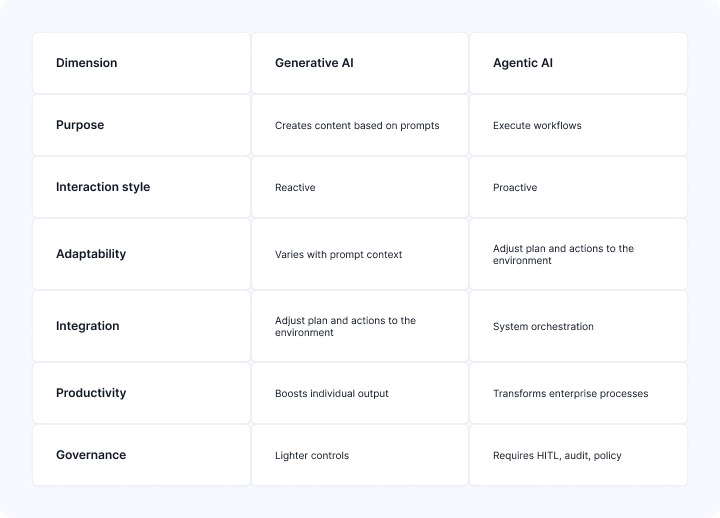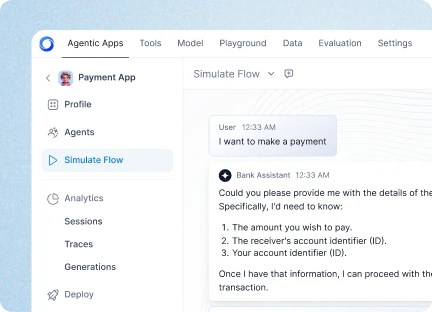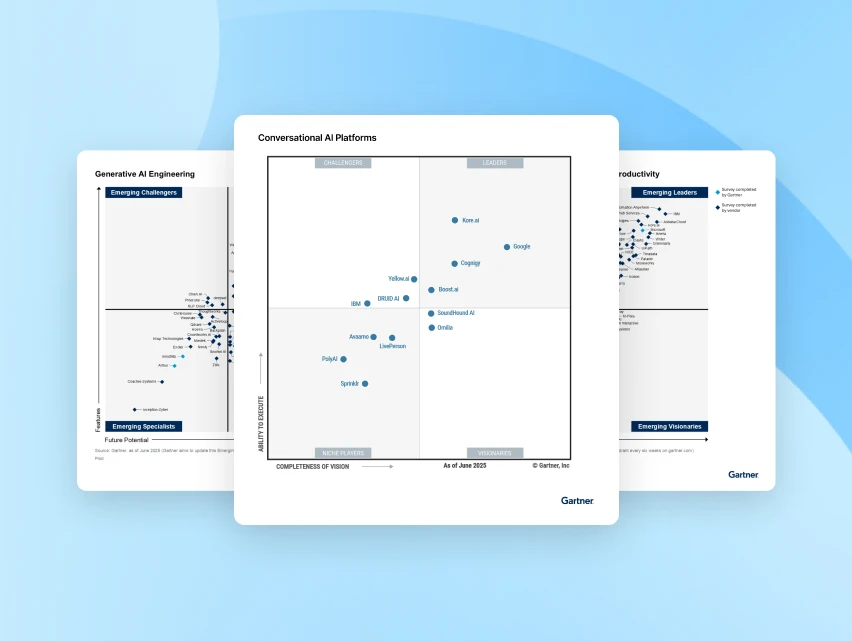Agentic AI vs Generative AI: Key differences enterprises need to know
While generative AI lowered the cost of creation, Agentic AI is lowering the cost of action.
Generative AI took the world by storm in 2022. It could write, summarize, design, and converse with human-like fluency. Yet, despite its widespread adoption, enterprise productivity barely moved. In fact, McKinsey reports that while 78% of enterprises have deployed GenAI in at least one function, 80% say it hasn’t improved productivity, cost, or revenue in any meaningful way.
The reason is that generative AI stops at generation. Yes, they assist, but they rarely act.
Agentic AI, on the other hand, is built to act. It can pursue goals, make decisions, and take autonomous action across systems. In short, if generative AI helps people produce, Agentic AI helps organizations perform, and in doing so, it’s rewriting the enterprise AI playbook.
In this guide, we’ll break down the key differences between Agentic AI and Generative AI, explore their impact on productivity, and unpack why enterprises are now turning from passive assistance to active intelligence.
What enterprises need to know (The TL;DR)
Before diving deep into the differences between Agentic AI and Generative AI, here are the key takeaways:
- Agentic AI ≠ Smarter generative AI. GenAI creates text, images, code, or designs based on prompts. Agentic AI acts. It plans and executes complex tasks end-to-end.
- Think beyond individual productivity. GenAI helps people work faster. Agentic AI transforms how work happens.
- Governance matters more than ever. The more autonomy AI gets, the more governance it needs. It needs clear goals, audit trails, data quality, and human oversight.
- The future isn’t GenAI or Agentic AI – it’s both. Together, they create the experience of a truly intelligent, human-like support agent.
Agentic AI vs generative AI: Differences leaders should know of
While both Agentic AI and Generative AI stem from the same foundation of large language models (LLMs), they serve fundamentally different purposes.

1. Purpose: Creation vs execution
Generative AI’s job is to create. Give it a prompt, and it will generate text, images, code, or audio in seconds. For instance, a marketing manager uses a GenAI to draft ten different versions of an email campaign.
Agentic AI, by contrast, exists to execute. It’s goal-oriented and built to act across systems. For instance, a supply-chain manager tells an AI agent, “When inventory falls under threshold X and delivery time exceeds Y, reorder and alert me.” The Agentic system monitors, triggers the order, updates the systems, and escalates if delays persist.
If the objective is to produce more content faster, GenAI is the tool. If you aim to deliver improved outcomes with fewer hand-offs and less manual coordination, Agentic AI is the way to go.
2. Interaction: Reactive vs proactive
Generative AI is reactive. This means it waits for you to ask before it moves. Ask it to write a blog, and it’ll produce one. Ask it to change the tone, and it’ll instantly rework the draft. Intelligent, yes, but it needs direction every step of the way.
Agentic AI, on the other hand, is proactive. It doesn’t wait for prompts. It monitors the environment, takes initiative, and orchestrates multi-step workflows.
Think of an insurance AI Agent that might spot a claim that looks high-risk. It automatically gathers more data, loops in a human for review if needed, records the decision, and then learn from the outcome to handle similar cases even better next time.
3. Adaptability: Contextual creation vs situational awareness
Generative AI is great at adapting within the context of the prompt. Ask it to change the tone of a message, shorten a paragraph, or rewrite a summary for a different audience, and it does exactly that. But once the content is delivered, it’s done. It doesn’t think about what comes next.
Agentic AI works differently. It perceives changes (new data, environment shifts, tool failures), adjusts its plan (breaks steps differently, calls different tools), learns from outcomes, and loops back.
Imagine a logistics AI agent that notices a shipment delay. Instead of waiting for human intervention, it reroutes deliveries, updates customers, and notifies the warehouse automatically.
In short, Generative AI can refine how something is done, but Agentic AI can rethink what should be done.
4. Tool-access: Standalone generation vs system orchestration
Generative AI usually works in isolation. You give it a prompt, it produces an output, and that’s where the interaction ends. It doesn’t naturally connect with the broader enterprise stack.
Agentic AI, in contrast, is deeply connected. It integrates tools, APIs, data sources, memory, and workflows. An Agentic system might read data from CRM, cross-check it against ERP inventory, send a follow-up email through a marketing platform, update a ticket in ServiceNow, and then analyse the results to improve its next set of actions.
This level of system orchestration makes Agentic AI a process engine rather than a point solution.
5. Impact on productivity: Individual output vs process transformation
Generative AI is great at helping people work faster. A marketer can produce dozens of copy variations in minutes, a developer can scaffold code snippets effortlessly, and a designer can spin up new mockups with just a few prompts. It supercharges individual output.
Agentic AI, meanwhile, changes how work gets done. By automating multi-step processes, it reduces manual touchpoints and shortens the time between decision and action. Imagine an AI agent that handles employee onboarding end-to-end: creating accounts, assigning access, sending welcome messages, running compliance checks, and generating reports, all without human intervention.
6. Governance: Content risk vs autonomy risk
With Generative AI, the main risks centre around what it produces – things like factual inaccuracies, hallucinations, biased outputs, or intellectual property concerns. These are manageable through review and validation, since the system only generates content when prompted.
Agentic AI introduces a new class of risks related to autonomy. Because it can act across systems with limited supervision, the stakes are higher. A poorly designed agent could take unintended actions, trigger downstream errors, or create confusion over who’s accountable for the outcome.
That’s why Agentic AI demands a stronger governance framework. It needs goal alignment, AI observability, explainability, agent auditability, and human-in-the-loop systems.
Agentic AI: The autonomous problem-solver
In the context of AI, the term "agentic" means the system has agency, where it can make decisions and act independently. Therefore, agentic AI refers to artificial intelligence that does not wait for instructions and instead takes autonomous, goal-driven actions on behalf of users.
Unlike GenAI, which waits for prompts, Agentic AI systems:
- Understand context and goals to make the right decisions
- Break down big objectives into smaller, actionable tasks
- Collaborate across systems, working with other agents, platforms, software, and tools
- Learn and adapt from experience to deliver better results over time
Put simply,
Traditional AI helps answer questions. Agentic AI helps achieve outcomes.
The power of Agentic AI lies in agentic workflows: multi-step tasks handled end-to-end by AI. These workflows let AI systems work on their own. Unlike rigid, rule-based workflows, agentic workflows adapt in real time, make decisions on the fly, and improve continuously based on feedback and outcomes.
In short, Agentic AI is the capability that lets AI act on its own, agentic workflows are how that capability comes to life.
How do agentic systems work?
Agentic AI operates through a cycle of perceiving, planning, and acting.
- Perceive: The system gathers data from its environment, sensors, APIs, or enterprise systems, to understand the current state.
- Plan: It interprets that data, breaks a complex goal into smaller steps, and determines the best sequence of actions to reach the objective.
- Act: It executes those actions across connected systems, monitors progress, and adjusts as conditions change.
What makes Agentic AI distinctive is its ability to chain tasks together. Unlike Generative AI, which typically completes one prompt at a time, an Agentic system can carry out multi-step workflows in sequence, and even create its own sub-goals along the way.
For instance, if you asked an Agentic AI to “build a marketing website,” it could write the copy, generate the visuals, code the structure, test functionality, and publish it, all from a single instruction. If an obstacle arises, say, a missing API key or broken link, it can diagnose the issue, generate a workaround, and continue without halting the process.
Where does agentic AI shine?
Agentic AI’s strength lies in its versatility. It can adapt across industries and business functions. Here are a few examples of where it’s already proving transformative:
- Healthcare and life sciences: AI agents can track patient data, coordinate appointments, adjust care plans based on new information, and alert healthcare professionals when required.
- Software development: Agentic AI can debug code, manage development lifecycles, test builds, and design system architecture autonomously.
- Employee support and operations: AI agents can handle both routine and essential tasks, such as onboarding employees, scheduling meetings, resolving IT tickets, or managing approvals.
- Finance and risk management: Agentic systems can analyze market movements in real time, execute trades, rebalance portfolios, and fine-tune risk models as new data streams in, all within defined guardrails.
- Manufacturing and supply chain: Agentic systems can monitor inventory, forecast demand, plan logistics, and automatically reorder materials when thresholds are met.
Read more about Agentic AI use cases and how it works
Generative AI: The creative powerhouse
Generative AI refers to advanced algorithms that can create content from text, code, and images, to data analysis autonomously. Unlike Agentic AI, which takes action to achieve goals, Generative AI’s purpose is creation. It responds to prompts by assembling knowledge, language, and structure into something new. It doesn’t decide what needs to be done, but simply delivers what it’s asked for, based on probabilities learned from its training data.
How does generative AI work?
At its core, Generative AI works through deep learning and pattern prediction. It studies enormous amounts of data, everything from text and code to images and sound, and learns the statistical relationships between elements. When prompted, it predicts what should come next, one token or pixel at a time, to generate coherent and contextually relevant content.
Where does generative AI shine?
Generative AI excels at tasks that involve creating or reimagining information, making it a natural fit for roles that depend on ideation or communication.
- Writing and content creation: From drafting emails and reports to scripting videos or generating social posts, GenAI tools help professionals produce high-quality content faster and in multiple variations.
- Image and video generation: Artists, designers, and marketers use GenAI to visualise ideas instantly — from product mockups to campaign visuals and even short videos generated from text prompts.
- Speech and music: AI can now clone voices, narrate audiobooks, compose original music, and even sing in multiple languages based on simple written inputs.
- Software development: Developers use GenAI-powered coding assistants to generate snippets, complete functions, detect bugs, and even refactor code in real time.
- Data augmentation: GenAI can create synthetic datasets that mimic real-world data, useful for testing, training, or anonymising sensitive information without exposing private data.
Read more about Generative AI and its benefits
Why are enterprises embracing Agentic AI?
As explained earlier, most GenAI tools, like chatbots, copilots, and assistants, largely stay at the surface. These tools improve individual productivity but don’t really transform end-to-end business processes.
This disconnect is now widely recognized as the GenAI Paradox:
Widespread adoption, limited business value.
Agentic AI flips this script and is now emerging as the solution to the GenAI paradox. AI agents, by design, are created to pursue goals and take action across systems. Here are four technological trends that enterprises are betting big on agentic AI:
- LLMs got smarter - Models like GPT-5, Claude 3, Gemini, Llama 3, now support contextual reasoning, memory, and tool use, making autonomous agents viable.
- API-first enterprises - most enterprises now run on API-first infrastructure. That means agents can now easily plug into CRMs, ERPs, HRMS, and communication tools.
- ROI is non-negotiable - as AI investments rise, C-suites are demanding measurable ROI. Agentic AI delivers measurable impact faster and helps in revenue generation.
- Architectural shifts - we’re moving from LLM-centric setups to Agentic Meshes composable ecosystems that support multi-agent collaboration and governance.
The bottom line is that enterprises in 2026 aren’t interested in assistants. They want autonomous execution. Agentic AI delivers that, and Gartner predicts that by 2028, 33% of enterprise software applications will include agentic capabilities.
Where do Agentic AI and generative AI complement each other?
While Agentic AI and Generative AI serve different purposes, they’re not competitors; they’re collaborators. Both bring different strengths to the table, and together they cover the full journey from idea to impact.
Generative AI writes, designs, and imagines. Agentic AI plans, decides, and delivers. When you combine the two, you get systems that don’t just come up with great ideas, but actually make them happen.
Take customer service, for example. An Agentic AI system can manage the flow of a conversation, decide when to escalate an issue, and pull data from backend systems. Meanwhile, a Generative AI model can create personalized responses that sound natural and empathetic. Together, they create the experience of a truly intelligent, human-like support agent.
The same collaboration plays out across industries:
- In marketing, an Agentic AI might run an email campaign end to end, identifying target audiences, scheduling messages, and tracking performance, while Generative AI writes the actual email copy and visuals for each segment.
- In IT or customer support, an agentic system can prioritize incoming tickets and assign them to the right teams, while a generative component drafts the responses or troubleshooting steps.
- In manufacturing, Generative AI could design new prototypes or recipes, while Agentic AI coordinates production, monitors machines, and ensures quality control.
What’s next in generative and Agentic AI
The line between Generative AI and Agentic AI is already starting to blur. As these technologies mature, we’re moving toward a future where creation and action will merge, where the same AI that imagines a solution can also bring it to life.
In this next phase, we’ll see systems that combine the creativity of Generative AI with the autonomy of Agentic AI. Imagine an AI that not only drafts a marketing strategy but also launches the campaign, measures the results, and refines the approach in real time. Or a healthcare AI that generates a new treatment plan and then coordinates the right follow-ups, tests, and notifications across systems, automatically.
This convergence will redefine productivity and innovation across every industry. Ultimately, the future of AI isn’t about choosing between Generative and Agentic; it’s about combining them thoughtfully.
Conclusion: Build for outcomes, not outputs
Generative AI showed the world what machines could create. Agentic AI is now showing what it can accomplish. Together, they represent the next great leap in enterprise intelligence, where creativity meets capability, and where insights evolve into action.
But this future won’t build itself. It requires vision, governance, and the right platform foundation to make AI reliable, scalable, and trustworthy across the enterprise.
That’s where Kore.ai comes in. Kore.ai provides a comprehensive platform that empowers enterprises to build, deploy, and scale both Generative and Agentic AI capabilities with confidence.
- Adopt and innovate with AI using secure, enterprise-grade tools designed for real-world impact.
- Simplify complexity with orchestration, governance, and integration frameworks that make AI easier to implement and manage.
- Deploy anywhere across cloud, on-premises, or hybrid environments, with the reliability and scalability global enterprises demand.
Want to explore how Agentic AI and GenAI can transform your enterprise? Request a custom demo and see how you can turn intent into impact.
FAQs
Q1. What is agentic AI vs generative AI?
Generative AI is designed to create. It produces content such as text, code, images, videos, or designs in response to human prompts. It’s excellent for ideation, communication, and creative tasks.
Agentic AI, on the other hand, is designed to act. It can set goals, make decisions, and take autonomous actions across connected systems. Instead of waiting for instructions, it executes workflows, from planning and orchestration to completion.
Q2. In what scenarios is agentic AI more valuable than generative AI?
Where generative AI remains ideal for content-centric tasks, Agentic AI delivers the most value in process-heavy, outcome-driven environments, such as:
- Customer service
- Operations
- Finance
- Human resources and recruitment
- IT and engineering
Q3. What data and governance challenges should enterprises consider with agentic AI vs generative AI?
Generative AI risks revolve around output quality, such as accuracy, hallucinations, bias, IP. Agentic AI introduces autonomy risks, such as poor data, misaligned goals, or unintended actions. It demands stronger governance, audit trails, secure integrations, and human oversight.
Q4. Can agentic AI replace generative AI?
No. Agentic AI doesn’t replace Generative AI, but it complements it. Agentic AI often uses Generative AI components to perform creative or communicative tasks within a workflow. For instance, an agentic system may rely on Generative AI to write an email, draft a report, or generate product descriptions.
Q5. What infrastructure or readiness is required for Agentic AI compared to Generative AI?
Generative AI can run on prebuilt tools, but Agentic AI needs a connected ecosystem. It requires deeper integrations, such as:
- API access to enterprise tools (CRM, ERP, HRMS)
- Reliable, governed data
- Clear workflows and guardrails
- Security and audit mechanisms
Q6. What is agentic washing? And how can enterprises avoid it?
Agentic washing is when vendors market basic GenAI tools as Agentic AI without real autonomy or integration. True Agentic AI can plan, act, adapt, and integrate across systems.
Enterprises should work with reliable vendors and should ask them for proof of multi-step execution and measurable outcomes.












.webp)
.jpg)



